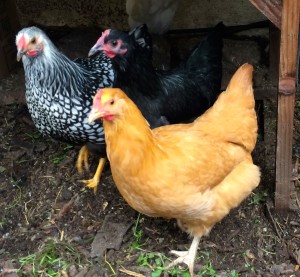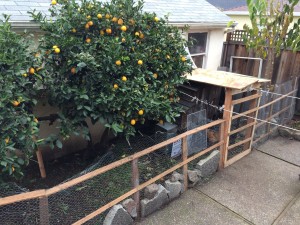Maybe you heard one of your friends talk about raising chickens in her backyard. You’re intrigued by the idea. Perhaps you like the idea of producing your own eggs, maybe you think chickens are cute, or maybe you think it would be a fun project you can brag about to your friends. You are hesitant. You have lots of questions. Will it be too noisy? How much will it cost? Do I have enough space? How much time will it take to take care of them? I went through the same process. It’s not as difficult as you may think. In this guide I’ll describe step by step how you can get started raising your own chickens.
If you are just getting started raising chickens in the city, I’m assuming
- You want enough eggs for your family and some surplus to share with friends.
- You enjoy animals and want to feel more connected to your food and nature.
- You don’t want your chickens waking you up at 5 am in the morning.
- You don’t want to deal with cleaning chicken poop every day.
- You don’t want to spend more than a few minutes a day caring for your flock.
- You don’t have a lot of space in your yard (perhaps only a few hundred square feet).
Here’s what I suggest:
1. Check your city ordinances. Make sure you are not breaking the law. More and more cities allow backyard chickens these days. Backyard Chickens has a page with information about the laws governing backyard chickens. In San Mateo, I’m allowed up to keep up to ten chickens, but no roosters. San Francisco only allows up to four chickens.
2. Start with four to six hens. This should give you at least 16 to 24 eggs a week, more in the summer and less in the winter. Keeping less than four chickens is more trouble than it’s worth, and caring for more than six might be too much if you’re just starting out. I recommend a docile, heavy breed such as Orpington, Australorp, Wyandotte, or Plymouth Rock.

My Silver Laced Wyandotte, Black Australorp, and Buff Orpington are best buddies and go everywhere together.
Docile so they don’t squawk and peck each other to death, and heavy so they don’t fly all over the place. If your chickens are docile and happy, they will make very little noise. You will hardly notice them if you are inside. Some common breeds such as White Leghorn and Rhode Island Red may lay more eggs, but can be more aggressive and harder to care for if you don’t have enough space. Chicken Breeds List has a good list of different breeds and their characteristics. I like to start from chicks so I can watch my chickens grow up. I don’t recommend hatching from eggs because it’s tricky and you will end up with some males. You can search Yelp to find places near you that sell baby chicks. When you buy your chicks the people at the store should be able to help you get started with a chick waterer, chick feeder, chick feed, bedding, and brooder light. I just use a cardboard box for the brooder. You can keep your chicks inside until they are about six weeks old. After that they are ready to go into their coop. Your chickens won’t start laying eggs until they are five or six months old. Backyard Chickens has some great tips on raising chicks.
3. Build an enclosed coop and run. A typical chicken coop consists of a hen house and a run. The hen house is where they lay their eggs and sleep, and the run is where they spend most of the day running around and scratching in the dirt. One alternative is a chicken tractor, which is a movable coop and run. I tried that for a while but there’s not enough grass in my backyard to make it work and my tractor is too small to use as a permanent coop. Another alternative is to let the chickens sleep in the hen house and free range during the day. The chickens love it, but they poop all over the place, kick mulch everywhere, and scratch up all the plants. I got tired of dealing with it and fenced them in.
You can buy prefabricated coops, but they tend to be expensive and way too small. I suggest building your own or buying a kit and assembling it yourself. Backyard chickens has some coop designs to inspire you if you want to build your own. I ordered a kit from Laughing Chickens and built a bigger run around it. I would recommend going for a bigger coop than they suggest. You will need a bare minimum of 8 square feet per bird in your coop and run, but bigger is always better. More space means happier chickens, which means less fighting, less noise, and more eggs. My coop and run is about 7′ x 20′, which is 140 square feet for eight chickens. Building the coop and run is the most time consuming and costly part of keeping chickens. Once you have a well-built coop and run, plan on spending just a few minutes a day refilling their food and water and collecting the eggs.
4. Use the deep litter method. Locate your coop and run on top of some dirt or grass and put a thick layer of mulch on top. Pine shavings, wood chips, and straw can all work. The mulch will absorb the chicken poop odor and the chickens’ constant scratching will eventually turn everything into a nice compost that you can apply to your garden. All you need to do is add more mulch every few months and the chickens will do the rest. Chicken poop will accumulate faster underneath their roosts in the coop, you should check and clean it out every week or two. You can clean out the litter once a year or so if you want to use it in the garden. Harvey Ussery has a good article on the deep litter method.
5. Use a nipple waterer and a hanging feeder. The most frequent maintenance tasks are feeding, watering, and collecting eggs. If you use a regular waterer, you will be cleaning poop out their water every few days. Instead, you should use a nipple watering system like the one below.
You just need to fill the bucket every week or so. For the feeder, a hanging feeder like the one below will work fine. Hang it off the ground so the chickens don’t kick dirt into their feed and poop in it. I suggest filling it every day. That way you won’t have leftovers to attract rats, the feed stays fresh, and you will learn just how much your chickens eat each day. If you are lazy or go on vacation, though, you can fill it up and the chickens will be fine for several days.
That should be enough information to get you started. There are plenty of books and online resources if you need more information. Good luck and have fun!






No Comments
Trackbacks/Pingbacks